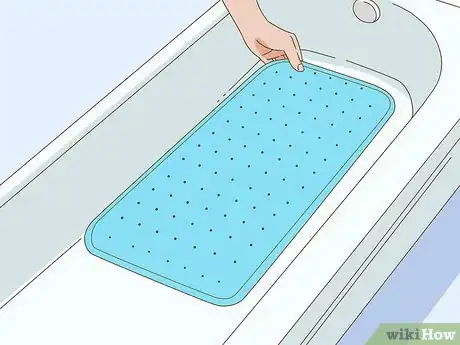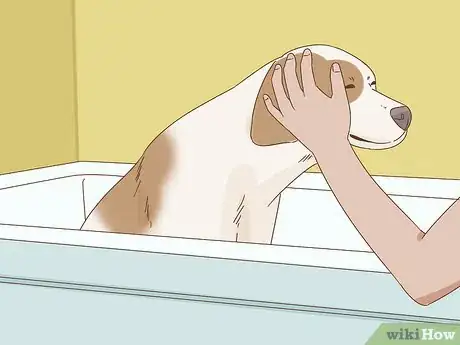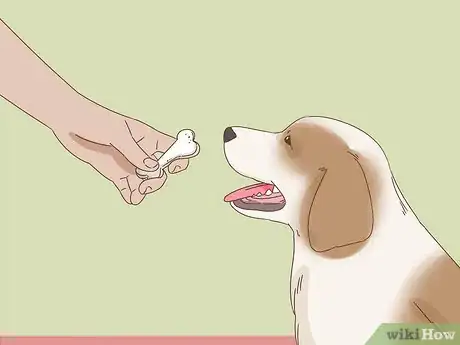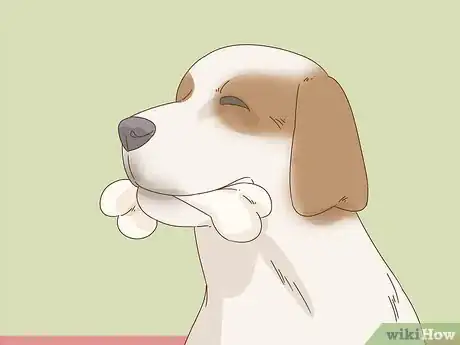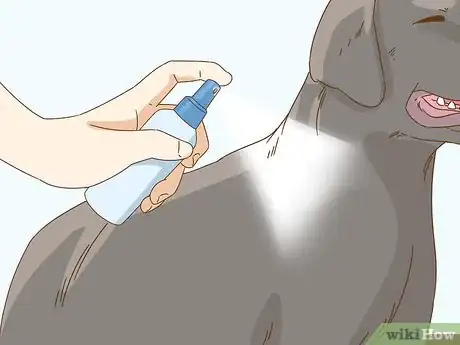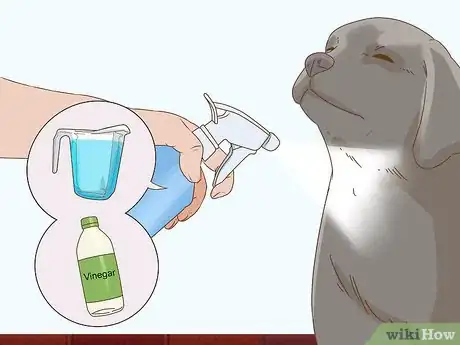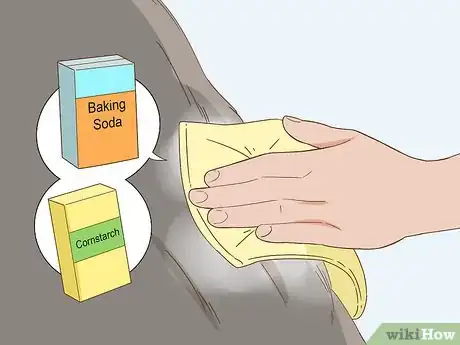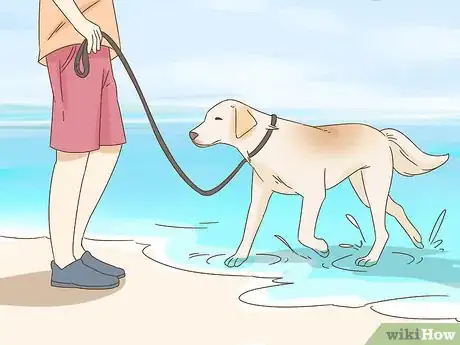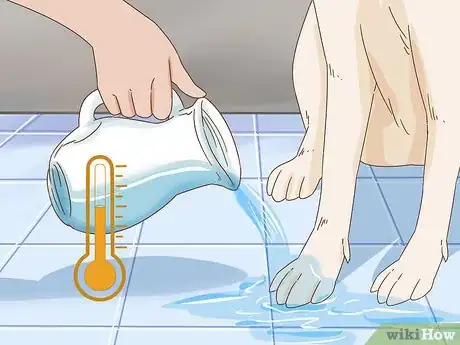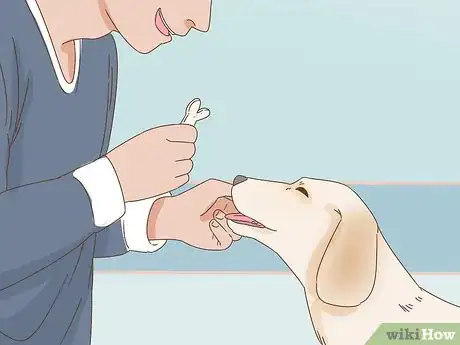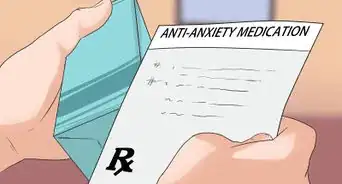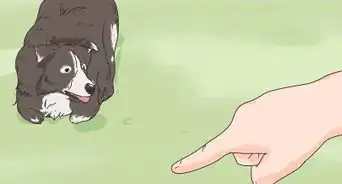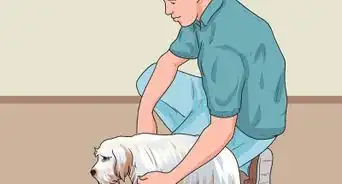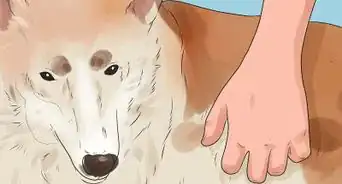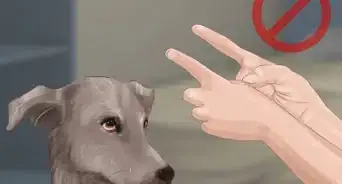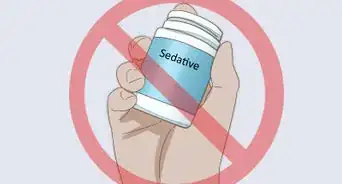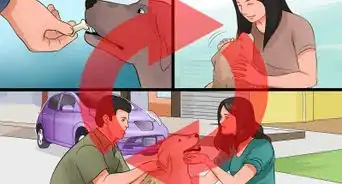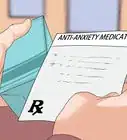This article was co-authored by Marie Lin. Marie Lin is a Licensed Pet Groomer and the Owner of Marie's Pet Grooming, a grooming salon based in New York City. Marie has over 10 years of pet grooming experience specializing in dogs and cats. She earned her pet grooming certification from the American Academy of Pet Grooming New York in 2009 and is also a member of the National Dog Groomers Association of America. She earned a Master of Business Administration (MBA) from Hawaii Pacific University in 2007.
There are 7 references cited in this article, which can be found at the bottom of the page.
This article has been viewed 34,031 times.
Bath time can be quite the ordeal for some dogs who are afraid of water or the bathtub and can turn into a game of chase all over the house. In some cases, you just need to get your dog used to water and reward it for staying calm during bath time. Use alternatives to water to clean and deodorize your dog if you just absolutely can’t get them comfortable with a bath, or for a quick clean when a whole bath isn’t necessary. Soon enough, getting clean won’t be such a big deal anymore!
Steps
Keeping Your Dog Calm in the Bath
-
1Put a rubber mat down in your bathtub. Bathtubs are slippery surfaces for dogs, so lay down an inexpensive rubber bath mat to help your dog feel more secure. Some dogs aren’t scared of the water itself, but don’t feel comfortable in bathtubs.[1]
- Cut your dog’s nails before bath time to help your dog have a more steady footing on the slippery surface.
- You can place a towel on the bottom of the tub if you don’t have a rubber mat.
-
2Practice having your dog in the tub with no water. Place your dog in the bathtub without turning on the faucet or shower head. Pet your dog and say “good dog” while it stays in the tub.[2]
- Don’t let your dog jump out of the tub and run away. You can use a leash to help keep your dog in place if it keeps trying to run away.
Advertisement -
3Reward your dog for staying calm in the tub with treats. Keep telling your dog it is a “good dog” while it remains in the tub. Give the dog a treat when it calms down and stops trying to get out of the tub.[3]
- You can start out with short sessions of 3-5 minutes in the tub with no water to get your dog used to being in the tub. Keep practicing this until the dog has no problem being in the tub.[4]
- Have a friend or helper distract the dog with treats or peanut butter while you bathe your dog so it stays more calm.
-
4Pour small amounts of water over your dog until you can give it a full bath. Gently pour warm water with a container over your dog’s legs and back once it is comfortable in the tub. Use a washcloth to clean the dog’s face instead of pouring water on it.[5]
- You can do this in multiple short sessions of 3-5 minutes, gradually increasing the amount of time your dog is in the tub and how much water you pour on it.
- Hold your dog’s chin and nose up as you pour water over the back of its neck and head to prevent water from getting in the dog’s eyes or nose.[6]
-
5Give your dog a long-lasting chew toy or treat after bathtime is over. Get your dog to associate a completed bath with a reward by giving it something like a rawhide or bone to chew on afterward. Your dog will learn to tolerate a bath because it expects a tasty reward when bath time is over.[7]
- Once your dog is comfortable with you pouring water over it to give it a bath, you can try using a pet spray attachment for your shower. These attachments reduce the pressure of the water and let you gently spray water over your dog so you don’t have to keep filling up a container.
Using Alternatives to Water
-
1Wipe your dog with pet wipes to clean spots of dirt off. There are many types of portable wipes designed just for pets. Use them to wipe off your dog’s paws or fur when they get dirty instead of giving your dog a whole bath.[8]
- Avoid rubbing your dog’s face or eyes with wipes as this can irritate them.
-
2Use freshening sprays or foams designed for dogs instead of water. Purchase a spray-on or rub-in waterless shampoo product designed for dogs. Follow the instructions on the product to apply it to your dog to clean it.[9]
- These types of products are good for a quick clean that doesn’t require any water to rinse the dog clean.
- Waterless shampoos generally work best for smaller dogs with less fur.
-
3Spritz your dog with a water and vinegar mixture to deodorize it. Mix equal parts apple cider vinegar and water in a spray bottle. Spray your dog’s coat all over with the mixture, then rub them dry with a clean towel.[10]
- Vinegar also helps treat dogs with itchy skin. Spray the mixture onto any spots that you see your dog is scratching a lot. The vinegar will even help repel fleas!
- You can use this mixture to clean your dog’s ears as well. Use a dropper to squeeze a drop or two of the mixture into your dog’s ears, then let the dog shake its head. You can also soak cotton balls in the mixture to wipe out the ears.
- You can also use apple cider vinegar to make a natural dog shampoo.
-
4Rub baking soda and cornstarch into your dog’s fur for a homemade dry shampoo. Mix 1 cup (120 g) of baking soda with 1 cup (120 g) of cornstarch for a mid-sized dog. Sprinkle it evenly over your dog’s fur and massage it in with a towel, then brush it out with a dog brush.
- This homemade dry shampoo will absorb grease and dirt from your dog’s fur and eliminate odors.
- You can add 2-3 drops of essential oil, like lemon or lavender, to make your dog smell even fresher.
- Use 1/2 cup (60 g) of baking soda and 1/2 cup (60 g) of cornstarch for smaller dogs.
Getting Your Dog Used to Water
-
1Take your dog to wade in shallow water. Lead the dog near shallow water at a beach, lake, pond, or kiddie pool on a leash and reward the dog with praise and a treat for getting near the water or touching the water. Let the dog make all its own choices about the water and do not try to force them into it.[11]
- Take your dog near the water for 5-minute sessions, then come back another day and repeat the process until they get comfortable being around water and getting wet.
- Try throwing a toy your dog loves into the water close to the shore to encourage them to wade in and retrieve it.
- Avoid rivers because the moving water can scare your dog.
-
2Play with your dog in the rain to make getting wet fun. Take your dog outside when it rains lightly and play fetch with a favorite ball or toy. Reward your dogs with treats and praise for playing and getting wet in the rain.[12]
- Dry the dog off as soon as playtime is over and you go inside so they associate being wet with having fun.
-
3Pour warm water on your dog’s feet to get it ready for bathing. Introduce your dog to the water by filling a container with lukewarm water and pouring it on their feet until they are comfortable with it. Don’t spray running water directly on your dog to avoid scaring them.[13]
- Use a leash or hold your dog by the collar to keep it from running away.
- Give your dog a treat if it remains calm while you pour water over its feet.
-
4Reward your dog with a treat and praise every time they interact with water. Reinforce any kinds of positive interactions your dog has with water. Dogs will begin to associate being wet with getting a tasty treat.
- Treat training is really effective for teaching dogs any kind of behavior that you want them to learn.
Expert Q&A
-
QuestionHow do you bathe a dog?
 Marie LinMarie Lin is a Licensed Pet Groomer and the Owner of Marie's Pet Grooming, a grooming salon based in New York City. Marie has over 10 years of pet grooming experience specializing in dogs and cats. She earned her pet grooming certification from the American Academy of Pet Grooming New York in 2009 and is also a member of the National Dog Groomers Association of America. She earned a Master of Business Administration (MBA) from Hawaii Pacific University in 2007.
Marie LinMarie Lin is a Licensed Pet Groomer and the Owner of Marie's Pet Grooming, a grooming salon based in New York City. Marie has over 10 years of pet grooming experience specializing in dogs and cats. She earned her pet grooming certification from the American Academy of Pet Grooming New York in 2009 and is also a member of the National Dog Groomers Association of America. She earned a Master of Business Administration (MBA) from Hawaii Pacific University in 2007.
Licensed Pet Groomer When you're washing your dog, start from the back of the dog's body and work your way forward. Use gentle water pressure, especially when you're washing the face, and make sure the water temperature is lukewarm. Remember, a dog's body temperature is a few degrees higher than ours, so the water should be cooler than you'd use on your own body.
When you're washing your dog, start from the back of the dog's body and work your way forward. Use gentle water pressure, especially when you're washing the face, and make sure the water temperature is lukewarm. Remember, a dog's body temperature is a few degrees higher than ours, so the water should be cooler than you'd use on your own body. -
QuestionWhat if I'm the one who is afraid of water?
 Community AnswerIf you don't want to wash your dog because you're afraid of water, take your dog to a professional groomer.
Community AnswerIf you don't want to wash your dog because you're afraid of water, take your dog to a professional groomer. -
QuestionMy dog is terrified of water, she won't even go near it, during bath time we feed her lots of treats but even that doesn't help. I don't know what to do anymore.
 Community AnswerWater can scare dogs. You can get her used to bathing again if you make her feel comforted by rubbing her body with your hands as you slowly add water to her paws first. Allow her to turn her head close to your body if she needs warmth while bathing. Use a gentle handheld shower on slow to gently pour water on her, from her paws to the top of her. Don't stop rubbing and petting her as you do this, and talk gently to reassure her. Avoid squeezing or holding her tightly. Don't stop her from shaking all the water away as she likes. Avoid prolonged baths. Keep this up regularly until she gets better around water.
Community AnswerWater can scare dogs. You can get her used to bathing again if you make her feel comforted by rubbing her body with your hands as you slowly add water to her paws first. Allow her to turn her head close to your body if she needs warmth while bathing. Use a gentle handheld shower on slow to gently pour water on her, from her paws to the top of her. Don't stop rubbing and petting her as you do this, and talk gently to reassure her. Avoid squeezing or holding her tightly. Don't stop her from shaking all the water away as she likes. Avoid prolonged baths. Keep this up regularly until she gets better around water.
References
- ↑ https://www.petfinder.com/dogs/dog-grooming/getting-dog-to-like-baths/
- ↑ https://www.petfinder.com/dogs/dog-grooming/getting-dog-to-like-baths/
- ↑ http://www.vetstreet.com/our-pet-experts/help-my-dog-hates-taking-a-bath
- ↑ https://www.petfinder.com/dogs/dog-grooming/getting-dog-to-like-baths/
- ↑ https://www.petfinder.com/dogs/dog-grooming/getting-dog-to-like-baths/
- ↑ http://www.vetstreet.com/our-pet-experts/help-my-dog-hates-taking-a-bath
- ↑ http://www.vetstreet.com/our-pet-experts/help-my-dog-hates-taking-a-bath
- ↑ https://barkpost.com/life/dog-clean-without-bath/
- ↑ http://www.dermoscent.com/en/our-advice/fiche-sos-hygiene-for-dogs-and-cats-why-and-how-to-cleanse-with-a-dry-shampoo_159.html
About This Article
Before you try to wash a dog that's afraid of water, get it used to being in water by taking it to the beach, walking it in the rain, or playing with it in a kiddie pool. Once your dog is more comfortable around water, practice placing it in the tub without any water on, and give it lots of treats to make the experience a positive one. Then, when you actually bathe your dog, use small amounts of warm water so you don't overwhelm it, and give it an extra special, long-lasting treat when you're finished. To learn how to bathe your dog without using water at all, scroll down!
